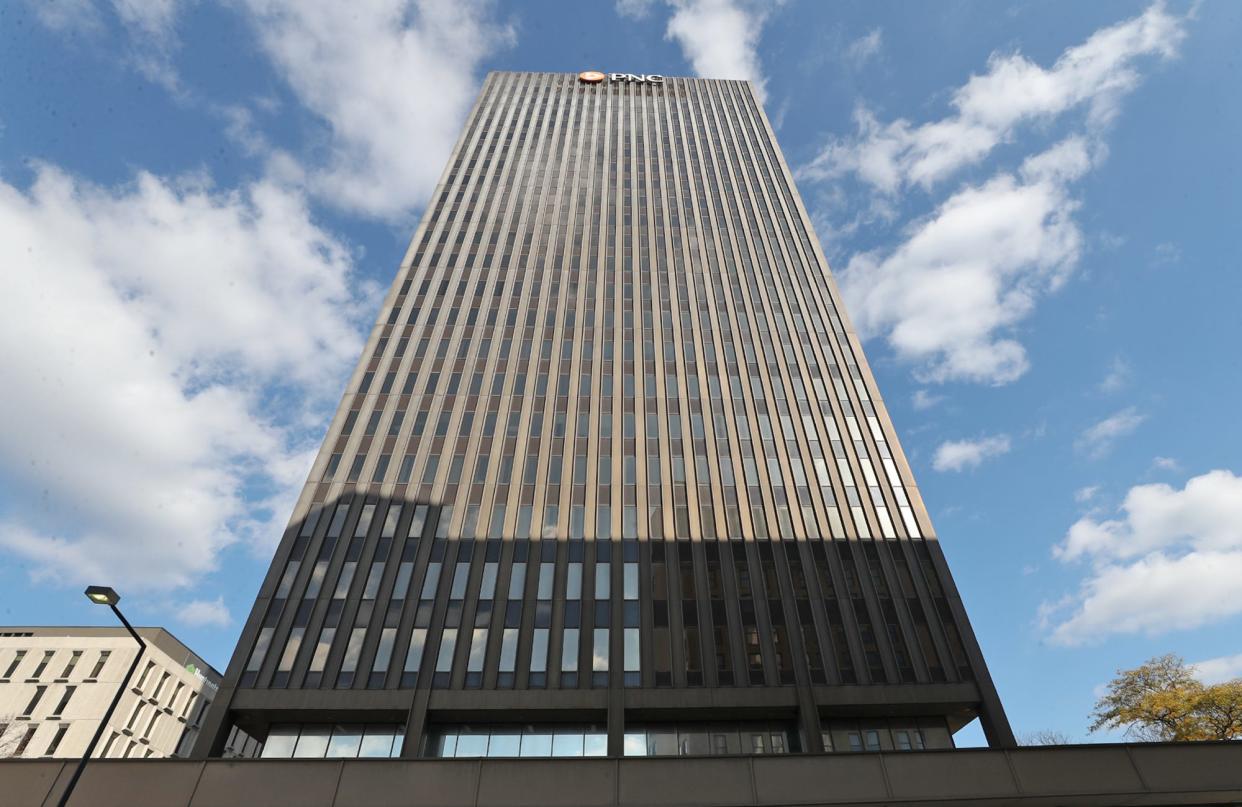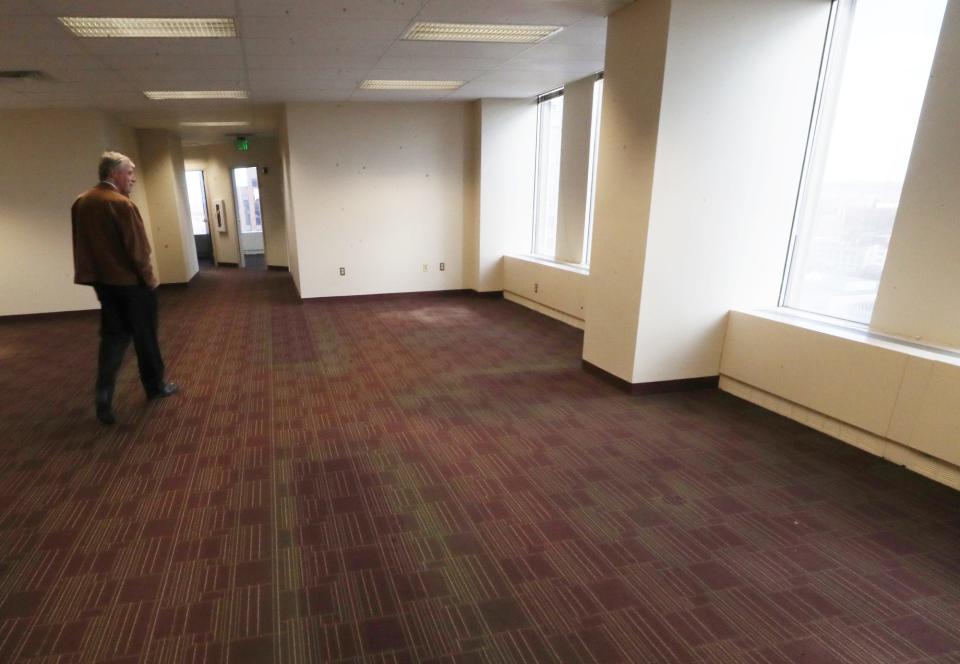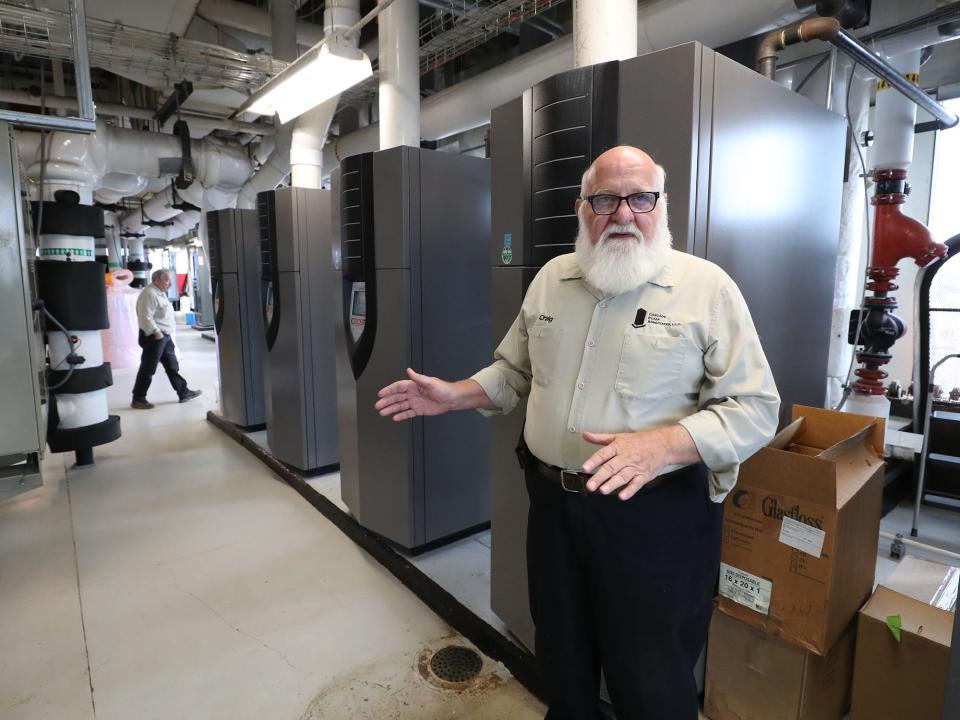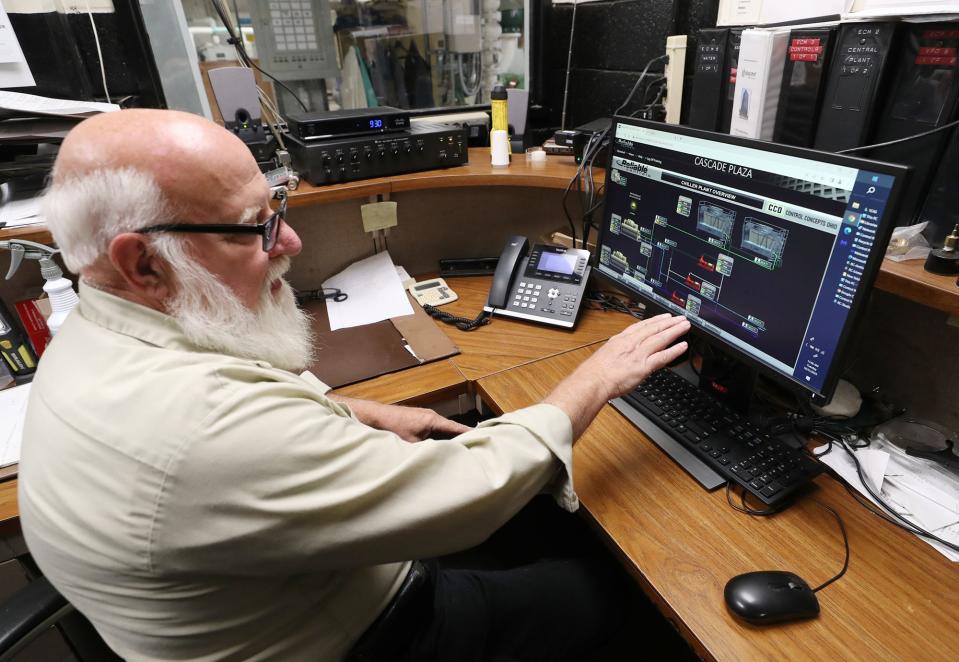The Cascade effect: How efforts to save a building may rescue downtown Akron

Trouble started last year at 1 Cascade Plaza, the 23-story downtown Akron tower with the PNC sign on top.
Downtown Akron, like downtowns across the country, was struggling in the wake of the pandemic, when so many white-collar workers abruptly abandoned their offices to safely telecommute from home.
That seismic shift in how we work has remained even as concerns around COVID-19 lift. Many offices remain empty because employees continue to work entirely from home or only drop in to their offices a couple times a week.
During the summer of 2022, Arthur Goldner and Associates – a Chicago-area development company that bought 1 Cascade Plaza 33 years prior – missed a property tax payment of about $135,000 for half of a year.
Chris Burnham of Summit County’s Development Finance Authority (DFA) took note because a separate part of 1 Cascade’s half-year tax bill − about $240,000 − also went unpaid. That charge is a special assessment to pays back DFA for bonds it sold to fund an $8.5 million renovation project at the building in 2018.
“I called [Goldner] and said, ‘You’ve got to pay your taxes,’” Burnham recalled.

Goldner told Burnham his office rental space business was hurting because other businesses were cutting back on office space or eliminating it altogether.
In Akron, there was another problem, Goldner told Burnham. The Main Street reconstruction project – which started before the pandemic and left areas of the street and sidewalk torn up for years – hurt business, too.
Goldner’s plan was to sell the tower – the only Akron property his company owns, located at the corner of South Main and West Bowery streets – and he thought he had a developer lined up.
But selling wasn’t going to be easy.
Other large downtown Akron properties were also for sale or empty, particularly around Cascade Plaza, the heart of office towers downtown.
Huntington, which owns two buildings in the plaza, has been trying to sell its tower – the tallest in downtown Akron – since 2019.
A plan to develop luxury apartments in the empty Cascade Holiday Inn, more recently known as the Akron City Center Hotel before it closed in 2017, stalled amid COVID.
And nearby, FirstEnergy would soon announce it was moving its headquarters out of downtown altogether, though its offices had been largely empty since the pandemic and a simultaneous state corruption scandal involving FirstEnergy bribing lawmakers.
The problem with 1 Cascade, as Burnham saw it, was twofold.
If Goldner stopped paying his taxes and assessments, and the case went into a court foreclosure, it could drag on for years.
DFA could be on the hook to make the bond payments from its own reserves until the matter was resolved.
Then, there was the broader impact: Uncertainty.
1 Cascade was still a little more than half filled with tenants, but would they stay if the building was in foreclosure?
Hundreds of thousands of tax dollars could be potentially lost forever, and Akron’s second-tallest building could go dark.
In February, Goldner missed another tax payment and still hadn’t sealed a deal to sell 1 Cascade.
Burnham reached out to Goldner again. He gave Goldner until the end of May to pay up or sell.
If that didn’t happen, Burnham told Goldner, “we’re going to get the building.”
‘This community didn’t need one more vacant building downtown’
The Development Finance Authority – once known as the Summit County Port Authority – was created in 1993 to save abandoned local rail lines for future transportation needs.
As time passed, however, leaders realized the organization could be a powerful tool to spur economic development and reconfigured it as the economic development finance agency for Summit County.
Since 1999, DFA has issued over $1.5 billion in bonds, spread across 13 counties and 128 projects. Some of that has helped bolster downtown Akron, where DFA bonds have helped pay for everything from improvements to the Akron Civic Theater and Canal Park Stadium to the construction of Akron Fire Station No. 4 and the Bowery Project.
Burnham, president of DFA, had a plan to save 1 Cascade from foreclosure.
But it would take the cooperation of the Summit County Council, the Summit County Land Bank and the city of Akron.
To pull it off, they would have to work together, and quickly.
“People in Summit County tend to get along pretty well, and we tend to solve our problems together,” Burnham said. “We proved that with Goodyear…and Bridgestone.”
As Burnham reached out to leaders, everyone involved appeared to realize the importance of stabilizing 1 Cascade Plaza.
“Akron is the core of Summit County, and that is the center of our community,” said Patrick Bravo, executive director of the Summit County Land Bank, noting how many large buildings downtown were vacant, including the former home of the Akron Beacon Journal.
“Certainly, this community didn’t need one more vacant building downtown,” Bravo said.
Burnham said there was already a general model the group could use for 1 Cascade Plaza: The Oliver Ocasek government building on High Street downtown.
In 2021, the DFA worked with the city of Akron to buy the five-story building from the state of Ohio and convert much of the space into a new home for Akron Municipal Court.
In that case, the city paid the state about $5.1 million for the building and then signed over the deed to the DFA, whose board is filled with local CEOs of hospitals, banks, not-for-profits and other organizations.
The DFA then leased the property back to the city for 25 years. At the end of the lease, the city will own the building outright.
Having the city in the chain of title allows for some upgrades to be repaid with money saved on annual utility bills.
The Akron Municipal Court, long housed on the top floors of the Akron Police Department, is expected to open in the Ocasek building later this month.
Burnham thought the DFA, working with the county, city and land bank, could do something similar with 1 Cascade.
Behind the complex deal to save key piece of downtown Akron

Sean Vollman, Akron's deputy mayor for integrated development, said the group had several unique things working in their favor.
First, there was no outstanding mortgage on 1 Cascade. Goldner’s company owned the building outright, so there would be no bank fighting for its piece of ownership.
And, because Goldner used a property-assessed clean energy, or PACE, loan through DFA, there was a contract giving DFA power if Goldner defaulted.
Goldner used the PACE money for a complicated $8.5 million project to upgrade 1 Cascade’s energy efficiency and replace its old boiler, which was on the building’s top floor.
That PACE loan contract “put DFA in a position to step in and secure the building and get the tenants what they needed,” Vollman said.
The plan was for the DFA to get the title of 1 Cascade and turn it over to the land bank. Because the land bank is a nonprofit, there would be no tax on the building until it was sold to a private developer.
That land bank would have no role in managing the building. It would sign a master lease agreement that would bring in the same private company – OKSK, led by John Blickle, president of the Rubber City Arches chain of McDonald’s restaurants – that manages the Ocasek building.
The county would provide a $1.5 million line of credit, sort of like a home equity loan, to the DFA so that if the building needed repairs before it was sold, there would be a way to pay for it.
And the city of Akron, which owns the parking deck under the building, agreed to defer ground lease payments.
Unlike the Ocasek project, no money would change hands for 1 Cascade Plaza, and it would not be a government building, though a couple of government offices are located there, including Akron’s municipal taxing agency and AMATS, the Akron Metropolitan Area Transportation Study.
In one or two years, when the entities involved in taking over 1 Cascade anticipated they could line up a buyer and agree on a price, they’d sell the building, which would likely either remain offices or be a combination of offices and residences.
Burnham said the building is valued at about $7 million, but he wasn’t sure it would sell for that with so much other open space downtown.
Proceeds, after expenses, would then be used to repay at least some of the lost taxes.
“It’s a beautiful building,” said Bravo, who toured it over the summer. This is the largest project the land bank has been involved in.
“From the moment you walk in that building, you don’t notice anything is wrong,” he said. “It’s old and big, but a beautiful office.”
Everyone involved agreed to move forward.
1 Cascade Plaza gets new ownership

Over the summer, the DFA moved quickly to obtain the building through a deed in lieu of foreclosure, which avoided a court battle.
Because Goldner was in default, he lost the building to the DFA, which assumed liabilities on the property to avoid a court foreclosure.
Burnham said the building is in generally good condition, but there were a couple immediate issues.
The security business that provided 24-7 guards to 1 Cascade hadn’t been paid and wanted money it was owed. Goldner also neglected to pay for an elevator certification, Burnham said.
It cost about $1 million to resolve those issues and pay the DFA its next bond payment, about $230,000, he said.
“We wanted to avoid the situation from getting any worse…and assure the tenants the building would be properly functioning,” Burnham said.
Since DFA took title in August, the building remains about 55% occupied, with enough money in lease payments to pay for management and the bond payments to DFA, he said.
On Aug. 14, Summit County Council agreed to extend a $1.5 million line of credit to DFA. It’s interest free through December 2024.
If money is needed after that, the contract can be extended a year, but any loan will be charged at 4% interest rate. Burnham said he hopes DFA will not need to tap into the credit line at all.
Some on County Council during the public meeting thanked Burnham and others who put together the deal to intervene on the 200,000 square feet of offices inside 1 Cascade.
“The big thing for us, [Goldner] was in default to his tenants…they could have left,” Burnham told them. “No pun [intended], the cascade effect of that could have been pretty catastrophic.”
In early November, the title to 1 Cascade was with DFA and on its way to the land bank.
But 1 Cascade Plaza was stable.
Cascade Plaza saved, but downtown remains in flux
Property manager OKSK had hired two men who had worked in maintenance at 1 Cascade Plaza for years to stay on. Security was back and the elevators were working.
All the tenants in the building were staying on but one, Burnham said, and that tenant had planned to move out before DFA became involved.
From outside, the tower looked the same as always.
But there were few people on the sidewalks around Cascade Plaza — not nearly as many as there were just a few years ago, when Huntington’s tower was still FirstMerit Bank and office workers everywhere still reported for duty inside offices.
Vollman said Akron’s downtown remains in flux.
The residential market is still healthy, with more and more office space turning into apartments. At least 100 more are expected in the coming two years.
Downtown Akron's struggles: Work from home, started as a pandemic fix, is here to stay and downtown Akron is suffering
“I think 1 Cascade will ultimately be successful,” he said.
There has been talk with out-of-state developers who could see the building remain as offices or be remade into both offices and residences, Vollman said.
The completion of the Lock 3 renovation and the University of Akron’s $42 million overhaul of the former Polsky’s department store – putting UA’s front door on Akron’s Main Street – are going to be transformational for the downtown neighborhood, Vollman said.
But even now, he said, so many people don’t realize all downtown has to offer – even his own daughter, a student at Firestone high school.
Vollman said his daughter and a friend went downtown recently to hand out flyers for their theater production.
“When she came home, she said, ‘Why didn’t you ever tell me how many cool things there are downtown Akron?’” Vollman said.
“I literally tell you every day … the new restaurants, the Knight Stage, what’s going on at the Civic,” Vollman told her.
Downtown, he said, is trying to find the right mixture of office, residential and entertainment to drive momentum and density.
“If I was looking for an office space now, downtown would be the first place I’d go,” he said. “There’s certainly space available, parking is reasonable, and there’s just so much going on.”
This article originally appeared on Akron Beacon Journal: Akron leaders work together to save 1 Cascade Plaza from foreclosure

